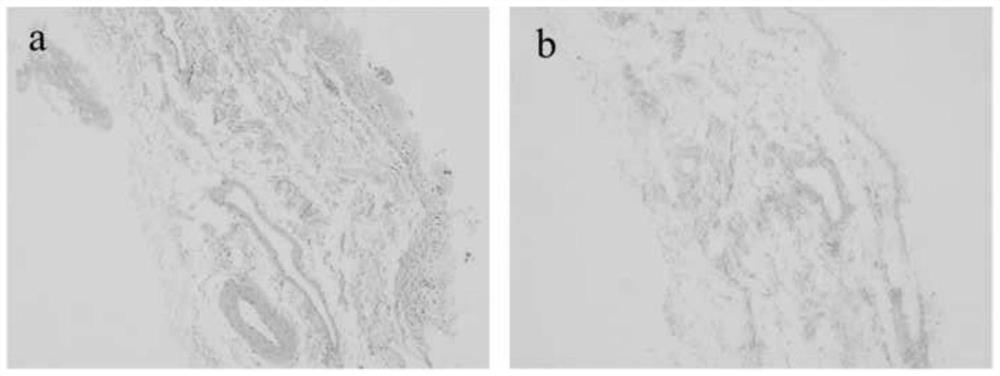Decellularized small intestinal submucosa/polylactic acid-glycolic acid copolymer composite scaffold as well as preparation method and application thereof
A small intestinal submucosa and glycolic acid technology, applied in medical science, tissue regeneration, prosthesis, etc., can solve problems such as unsatisfactory repair effect and suboptimal overall biological activity, achieve good tissue repair function, and promote mucosal repair. Effect of cell migration and growth, high biological activity
- Summary
- Abstract
- Description
- Claims
- Application Information
AI Technical Summary
Problems solved by technology
Method used
Image
Examples
preparation example Construction
[0032] The invention provides a method for preparing a decellularized small intestinal submucosa / polylactic acid-glycolic acid copolymer composite scaffold. The composite scaffold preparation method comprises: electrospinning a spinning solution containing polylactic acid-glycolic acid copolymer (PLGA) into On the decellularized small intestinal submucosa (dSIS), a decellularized small intestinal submucosa / polylactic acid-glycolic acid copolymer composite scaffold was prepared.
[0033] Poly(lactic-co-glycolic acid) was electrospun onto the decellularized small intestinal submucosa attached to the receiver by electrospinning to prepare a composite scaffold with a layered structure. The decellularized intestinal submucosa in the composite scaffold supported the growth of muscle layer cells, and the poly(lactic-co-glycolic acid) layer supported the growth of mucosal layer cells.
[0034] PLGA in the prior art is mainly used to mechanically enhance dSIS rather than promote epithe...
Embodiment 1
[0057] This example provides a method for preparing a decellularized small intestinal submucosa / polylactic acid-glycolic acid copolymer composite scaffold, which includes the preparation of decellularized small intestinal submucosa (dSIS) and the preparation of dSIS / PLGA composite scaffold.
[0058] Specifically, the preparation of decellularized small intestinal submucosa (dSIS) includes the following steps:
[0059] Small intestines were harvested from healthy pigs (about 6 months of age and about 100 kg body weight) within 4 hours of slaughter. The serosa, muscular layer, and mucosa were mechanically removed, and the remaining submucosa was rinsed with deionized water. The decellularization process included: (1) treatment of small intestinal submucosa (SIS) with acetone and ethanol (2:1, v / v), (2) treatment with 0.05% trypsin and 0.02% EDTA at 37°C for 8 h, (3 ) treated with 4% SDS and 3% TritonX-100 for 24h, (4) treated with 0.1% peracetic acid and 20% ethanol for 30min. ...
Embodiment 2
[0065] This example provides a method for preparing a decellularized small intestinal submucosa / polylactic acid-glycolic acid copolymer composite scaffold, which includes the preparation of decellularized small intestinal submucosa (dSIS) and the preparation of dSIS / PLGA composite scaffold.
[0066] Compared with Example 1, the only difference lies in the different number of stacked layers of single-layer dSIS and the different electrospinning conditions. In this example, 6 pieces of single-layer dSIS prepared as in Example 1 were stacked, and the electrospinning conditions were set as follows:
[0067] The voltage is 20kV, the flow rate of the needle is 3ml / h, and the distance from the needle tip to the receiver is 15cm. Electrospinning continued for 1 h to form dSIS / PLGA composite scaffolds.
PUM
| Property | Measurement | Unit |
|---|---|---|
| Diameter | aaaaa | aaaaa |
| Diameter | aaaaa | aaaaa |
Abstract
Description
Claims
Application Information
 Login to View More
Login to View More - R&D
- Intellectual Property
- Life Sciences
- Materials
- Tech Scout
- Unparalleled Data Quality
- Higher Quality Content
- 60% Fewer Hallucinations
Browse by: Latest US Patents, China's latest patents, Technical Efficacy Thesaurus, Application Domain, Technology Topic, Popular Technical Reports.
© 2025 PatSnap. All rights reserved.Legal|Privacy policy|Modern Slavery Act Transparency Statement|Sitemap|About US| Contact US: help@patsnap.com



